An Economic Analysis of Iron Ore Demand and Supply in Australia
VerifiedAdded on 2020/03/02
|7
|1135
|225
Report
AI Summary
This report examines the demand and supply dynamics of iron ore in Australia. It begins with an introduction to the fundamental economic concepts of demand and supply, explaining how they determine equilibrium price and quantity. The report then applies these concepts to the Australian iron ore market, highlighting Australia's position as a major exporter and its dependence on China's demand for steel. It analyzes the recent decline in iron ore prices, attributing it to slowing economic growth in China and reduced demand for steel. The report uses graphical representations to illustrate shifts in demand and supply curves and discusses the impact of excess supply. It also considers the lack of alternative demand sources and China's domestic iron ore production. The report concludes by emphasizing the cyclical nature of the market and the importance of operational efficiency for miners, suggesting that future recovery depends on China's economic resurgence. This report offers a comprehensive analysis of the iron ore market, connecting economic theory to real-world market trends.
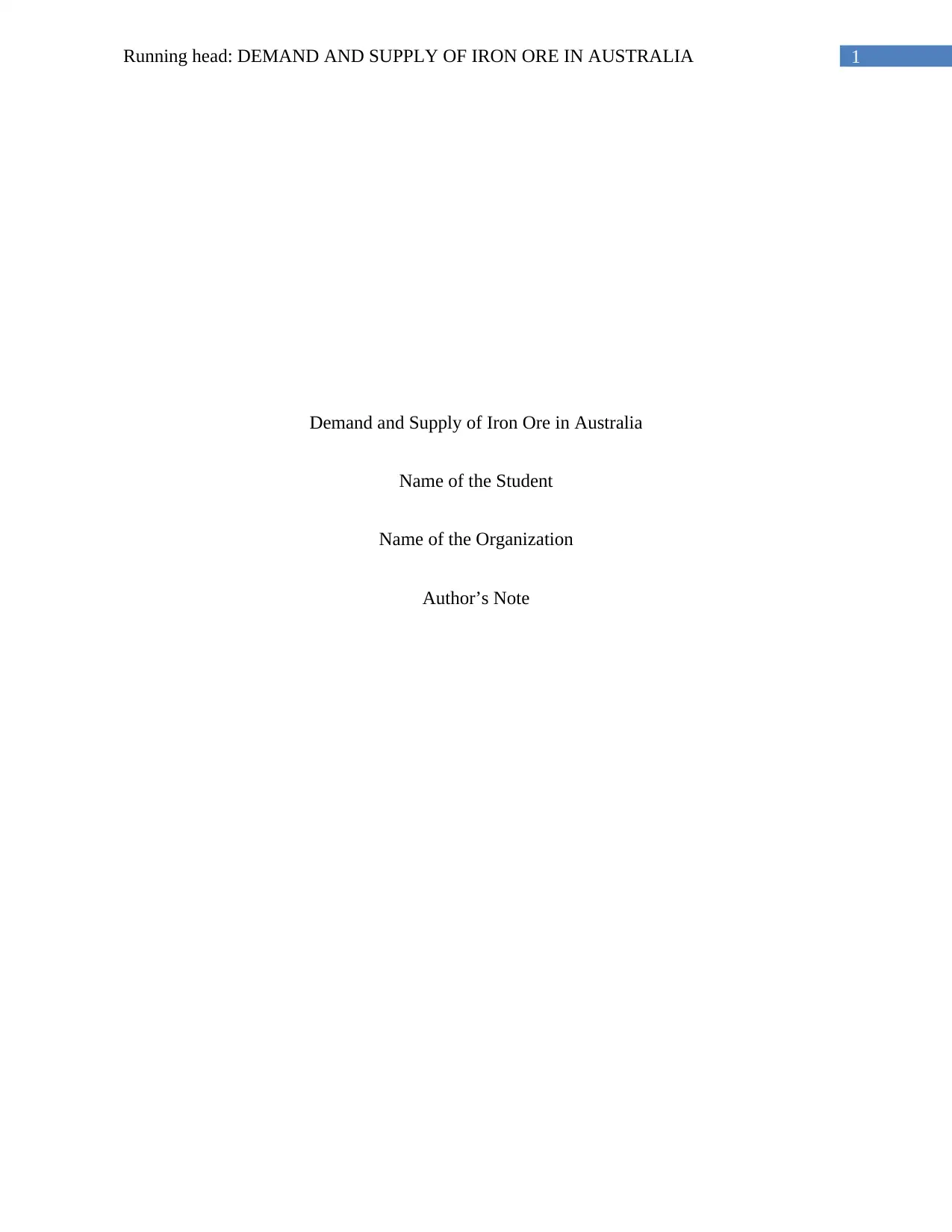
1Running head: DEMAND AND SUPPLY OF IRON ORE IN AUSTRALIA
Demand and Supply of Iron Ore in Australia
Name of the Student
Name of the Organization
Author’s Note
Demand and Supply of Iron Ore in Australia
Name of the Student
Name of the Organization
Author’s Note
Paraphrase This Document
Need a fresh take? Get an instant paraphrase of this document with our AI Paraphraser
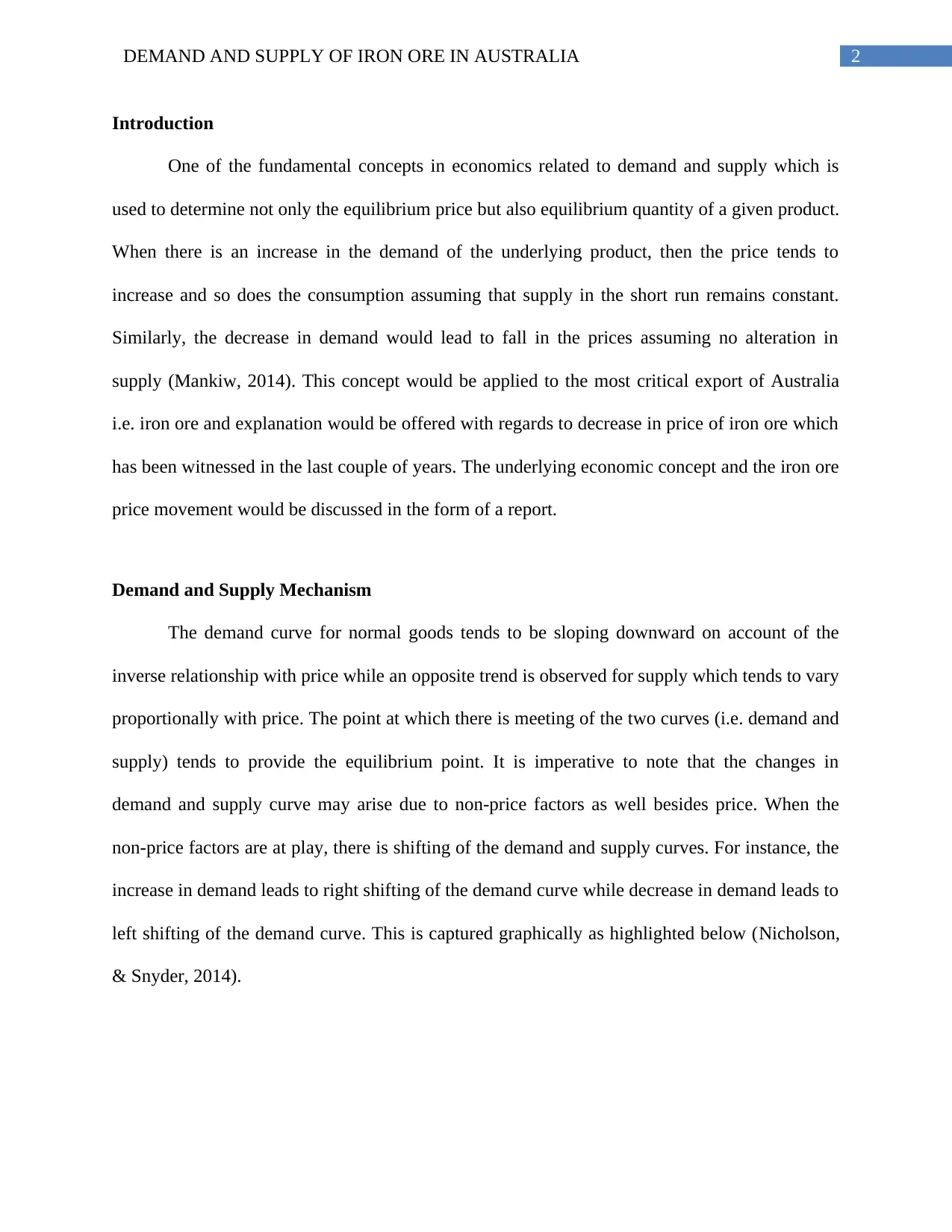
2DEMAND AND SUPPLY OF IRON ORE IN AUSTRALIA
Introduction
One of the fundamental concepts in economics related to demand and supply which is
used to determine not only the equilibrium price but also equilibrium quantity of a given product.
When there is an increase in the demand of the underlying product, then the price tends to
increase and so does the consumption assuming that supply in the short run remains constant.
Similarly, the decrease in demand would lead to fall in the prices assuming no alteration in
supply (Mankiw, 2014). This concept would be applied to the most critical export of Australia
i.e. iron ore and explanation would be offered with regards to decrease in price of iron ore which
has been witnessed in the last couple of years. The underlying economic concept and the iron ore
price movement would be discussed in the form of a report.
Demand and Supply Mechanism
The demand curve for normal goods tends to be sloping downward on account of the
inverse relationship with price while an opposite trend is observed for supply which tends to vary
proportionally with price. The point at which there is meeting of the two curves (i.e. demand and
supply) tends to provide the equilibrium point. It is imperative to note that the changes in
demand and supply curve may arise due to non-price factors as well besides price. When the
non-price factors are at play, there is shifting of the demand and supply curves. For instance, the
increase in demand leads to right shifting of the demand curve while decrease in demand leads to
left shifting of the demand curve. This is captured graphically as highlighted below (Nicholson,
& Snyder, 2014).
Introduction
One of the fundamental concepts in economics related to demand and supply which is
used to determine not only the equilibrium price but also equilibrium quantity of a given product.
When there is an increase in the demand of the underlying product, then the price tends to
increase and so does the consumption assuming that supply in the short run remains constant.
Similarly, the decrease in demand would lead to fall in the prices assuming no alteration in
supply (Mankiw, 2014). This concept would be applied to the most critical export of Australia
i.e. iron ore and explanation would be offered with regards to decrease in price of iron ore which
has been witnessed in the last couple of years. The underlying economic concept and the iron ore
price movement would be discussed in the form of a report.
Demand and Supply Mechanism
The demand curve for normal goods tends to be sloping downward on account of the
inverse relationship with price while an opposite trend is observed for supply which tends to vary
proportionally with price. The point at which there is meeting of the two curves (i.e. demand and
supply) tends to provide the equilibrium point. It is imperative to note that the changes in
demand and supply curve may arise due to non-price factors as well besides price. When the
non-price factors are at play, there is shifting of the demand and supply curves. For instance, the
increase in demand leads to right shifting of the demand curve while decrease in demand leads to
left shifting of the demand curve. This is captured graphically as highlighted below (Nicholson,
& Snyder, 2014).
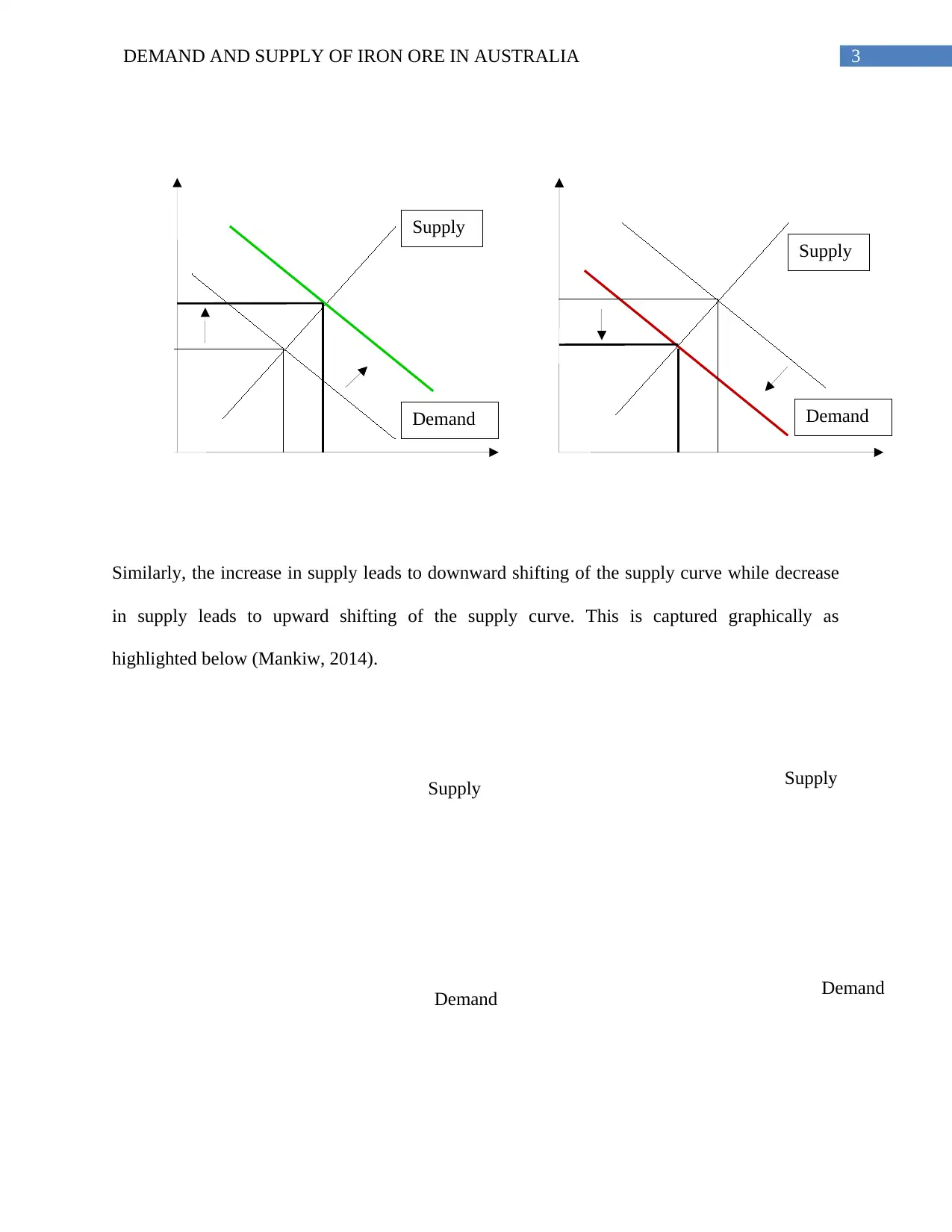
3DEMAND AND SUPPLY OF IRON ORE IN AUSTRALIA
Supply
Supply
Demand Demand
Demand
Supply Supply
Demand
Similarly, the increase in supply leads to downward shifting of the supply curve while decrease
in supply leads to upward shifting of the supply curve. This is captured graphically as
highlighted below (Mankiw, 2014).
Supply
Supply
Demand Demand
Demand
Supply Supply
Demand
Similarly, the increase in supply leads to downward shifting of the supply curve while decrease
in supply leads to upward shifting of the supply curve. This is captured graphically as
highlighted below (Mankiw, 2014).
⊘ This is a preview!⊘
Do you want full access?
Subscribe today to unlock all pages.

Trusted by 1+ million students worldwide
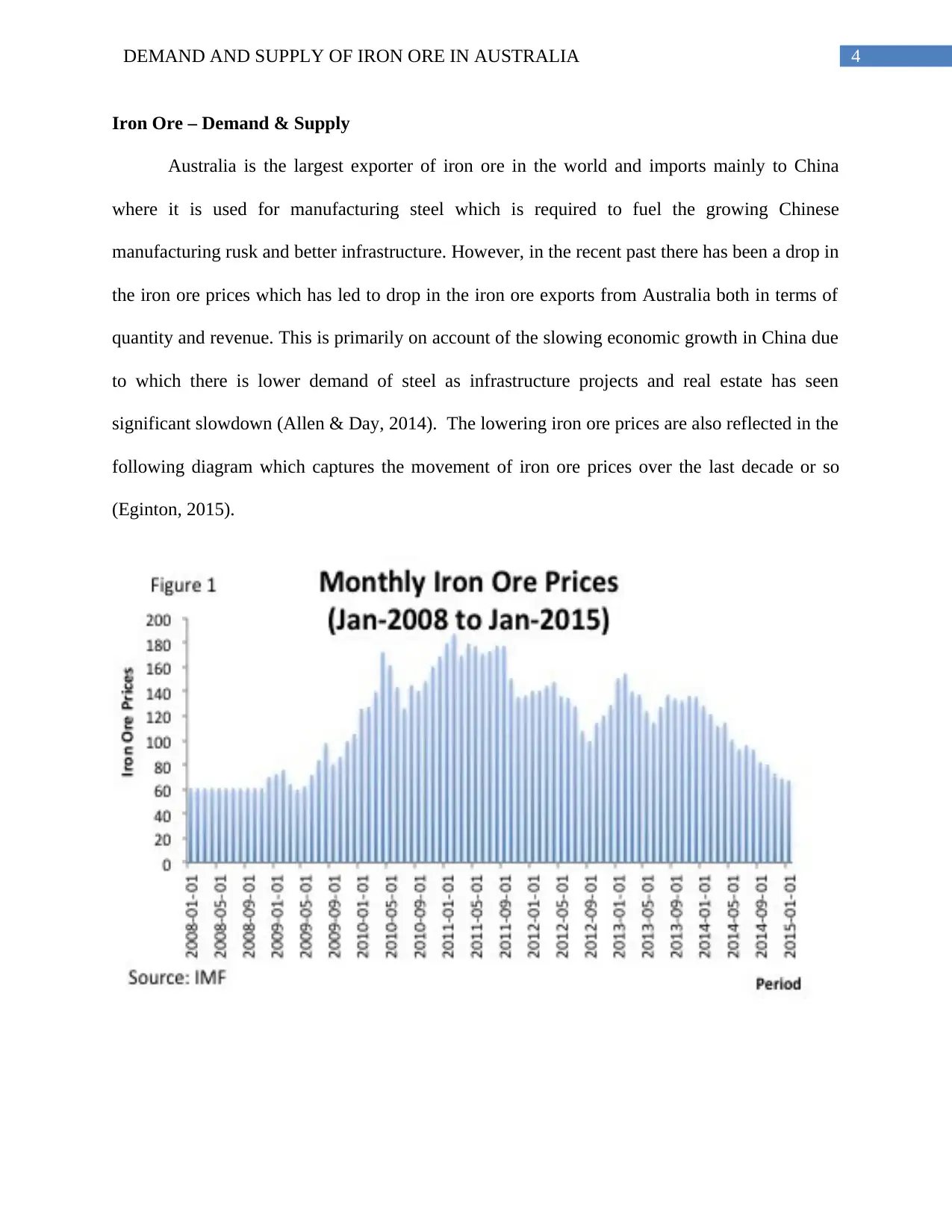
4DEMAND AND SUPPLY OF IRON ORE IN AUSTRALIA
Iron Ore – Demand & Supply
Australia is the largest exporter of iron ore in the world and imports mainly to China
where it is used for manufacturing steel which is required to fuel the growing Chinese
manufacturing rusk and better infrastructure. However, in the recent past there has been a drop in
the iron ore prices which has led to drop in the iron ore exports from Australia both in terms of
quantity and revenue. This is primarily on account of the slowing economic growth in China due
to which there is lower demand of steel as infrastructure projects and real estate has seen
significant slowdown (Allen & Day, 2014). The lowering iron ore prices are also reflected in the
following diagram which captures the movement of iron ore prices over the last decade or so
(Eginton, 2015).
Iron Ore – Demand & Supply
Australia is the largest exporter of iron ore in the world and imports mainly to China
where it is used for manufacturing steel which is required to fuel the growing Chinese
manufacturing rusk and better infrastructure. However, in the recent past there has been a drop in
the iron ore prices which has led to drop in the iron ore exports from Australia both in terms of
quantity and revenue. This is primarily on account of the slowing economic growth in China due
to which there is lower demand of steel as infrastructure projects and real estate has seen
significant slowdown (Allen & Day, 2014). The lowering iron ore prices are also reflected in the
following diagram which captures the movement of iron ore prices over the last decade or so
(Eginton, 2015).
Paraphrase This Document
Need a fresh take? Get an instant paraphrase of this document with our AI Paraphraser
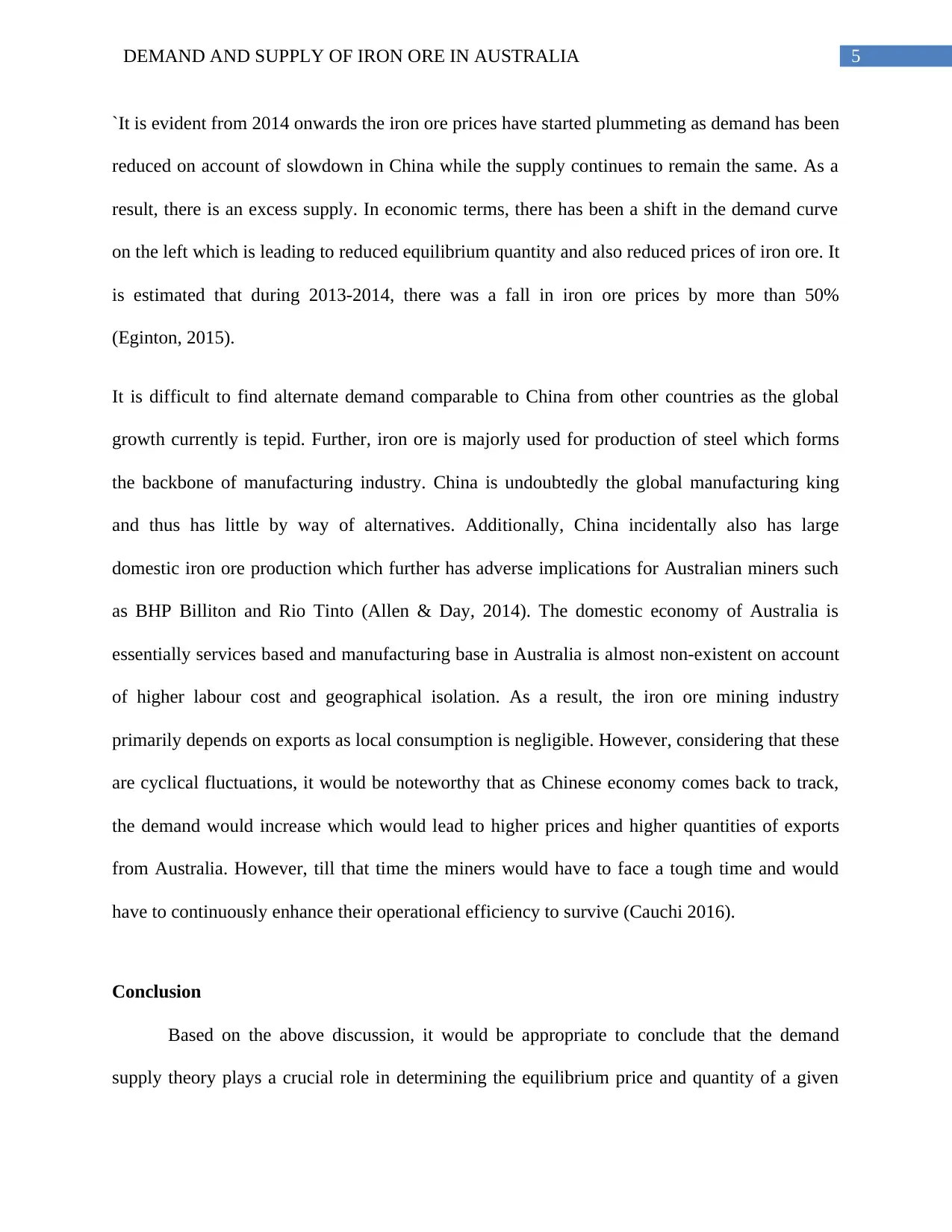
5DEMAND AND SUPPLY OF IRON ORE IN AUSTRALIA
`It is evident from 2014 onwards the iron ore prices have started plummeting as demand has been
reduced on account of slowdown in China while the supply continues to remain the same. As a
result, there is an excess supply. In economic terms, there has been a shift in the demand curve
on the left which is leading to reduced equilibrium quantity and also reduced prices of iron ore. It
is estimated that during 2013-2014, there was a fall in iron ore prices by more than 50%
(Eginton, 2015).
It is difficult to find alternate demand comparable to China from other countries as the global
growth currently is tepid. Further, iron ore is majorly used for production of steel which forms
the backbone of manufacturing industry. China is undoubtedly the global manufacturing king
and thus has little by way of alternatives. Additionally, China incidentally also has large
domestic iron ore production which further has adverse implications for Australian miners such
as BHP Billiton and Rio Tinto (Allen & Day, 2014). The domestic economy of Australia is
essentially services based and manufacturing base in Australia is almost non-existent on account
of higher labour cost and geographical isolation. As a result, the iron ore mining industry
primarily depends on exports as local consumption is negligible. However, considering that these
are cyclical fluctuations, it would be noteworthy that as Chinese economy comes back to track,
the demand would increase which would lead to higher prices and higher quantities of exports
from Australia. However, till that time the miners would have to face a tough time and would
have to continuously enhance their operational efficiency to survive (Cauchi 2016).
Conclusion
Based on the above discussion, it would be appropriate to conclude that the demand
supply theory plays a crucial role in determining the equilibrium price and quantity of a given
`It is evident from 2014 onwards the iron ore prices have started plummeting as demand has been
reduced on account of slowdown in China while the supply continues to remain the same. As a
result, there is an excess supply. In economic terms, there has been a shift in the demand curve
on the left which is leading to reduced equilibrium quantity and also reduced prices of iron ore. It
is estimated that during 2013-2014, there was a fall in iron ore prices by more than 50%
(Eginton, 2015).
It is difficult to find alternate demand comparable to China from other countries as the global
growth currently is tepid. Further, iron ore is majorly used for production of steel which forms
the backbone of manufacturing industry. China is undoubtedly the global manufacturing king
and thus has little by way of alternatives. Additionally, China incidentally also has large
domestic iron ore production which further has adverse implications for Australian miners such
as BHP Billiton and Rio Tinto (Allen & Day, 2014). The domestic economy of Australia is
essentially services based and manufacturing base in Australia is almost non-existent on account
of higher labour cost and geographical isolation. As a result, the iron ore mining industry
primarily depends on exports as local consumption is negligible. However, considering that these
are cyclical fluctuations, it would be noteworthy that as Chinese economy comes back to track,
the demand would increase which would lead to higher prices and higher quantities of exports
from Australia. However, till that time the miners would have to face a tough time and would
have to continuously enhance their operational efficiency to survive (Cauchi 2016).
Conclusion
Based on the above discussion, it would be appropriate to conclude that the demand
supply theory plays a crucial role in determining the equilibrium price and quantity of a given
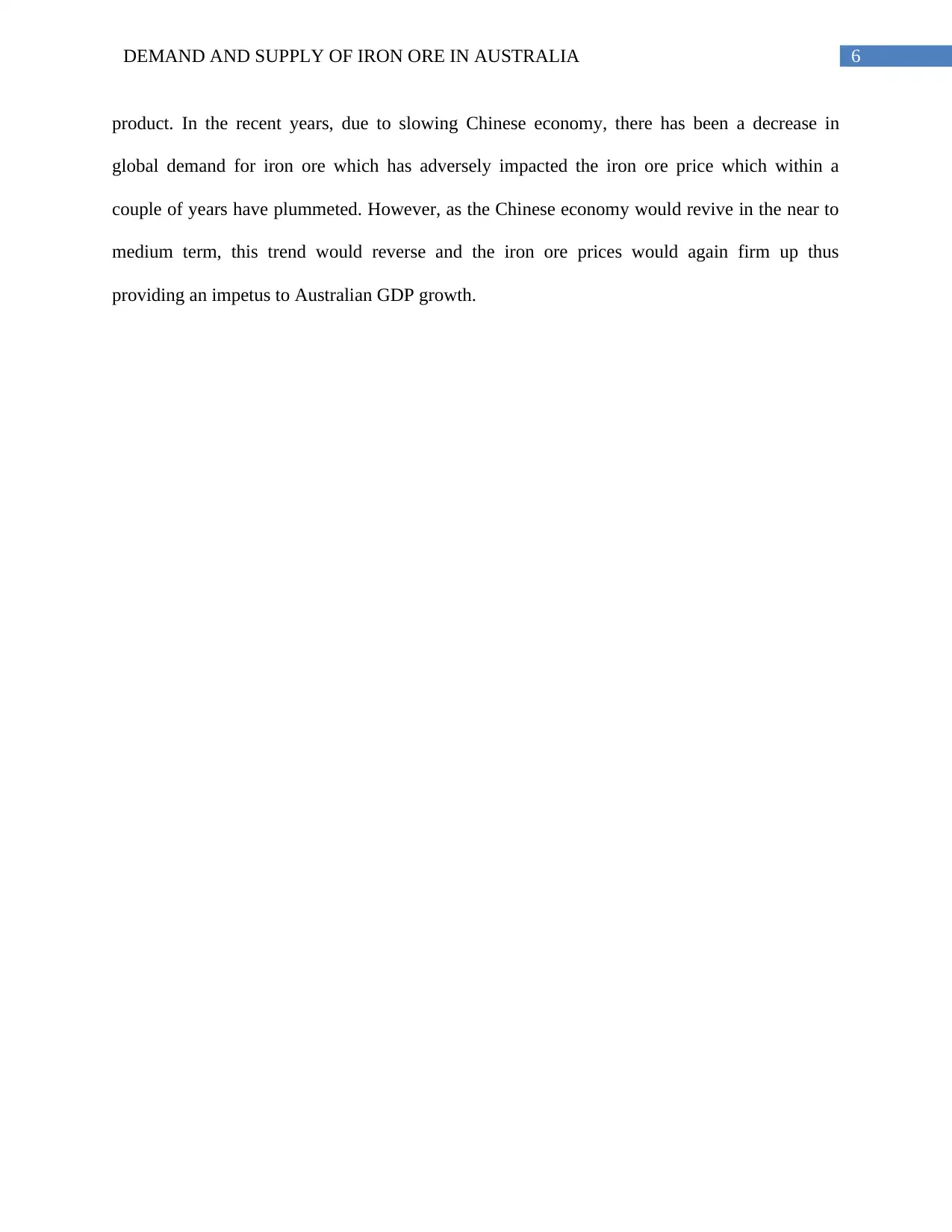
6DEMAND AND SUPPLY OF IRON ORE IN AUSTRALIA
product. In the recent years, due to slowing Chinese economy, there has been a decrease in
global demand for iron ore which has adversely impacted the iron ore price which within a
couple of years have plummeted. However, as the Chinese economy would revive in the near to
medium term, this trend would reverse and the iron ore prices would again firm up thus
providing an impetus to Australian GDP growth.
product. In the recent years, due to slowing Chinese economy, there has been a decrease in
global demand for iron ore which has adversely impacted the iron ore price which within a
couple of years have plummeted. However, as the Chinese economy would revive in the near to
medium term, this trend would reverse and the iron ore prices would again firm up thus
providing an impetus to Australian GDP growth.
⊘ This is a preview!⊘
Do you want full access?
Subscribe today to unlock all pages.

Trusted by 1+ million students worldwide
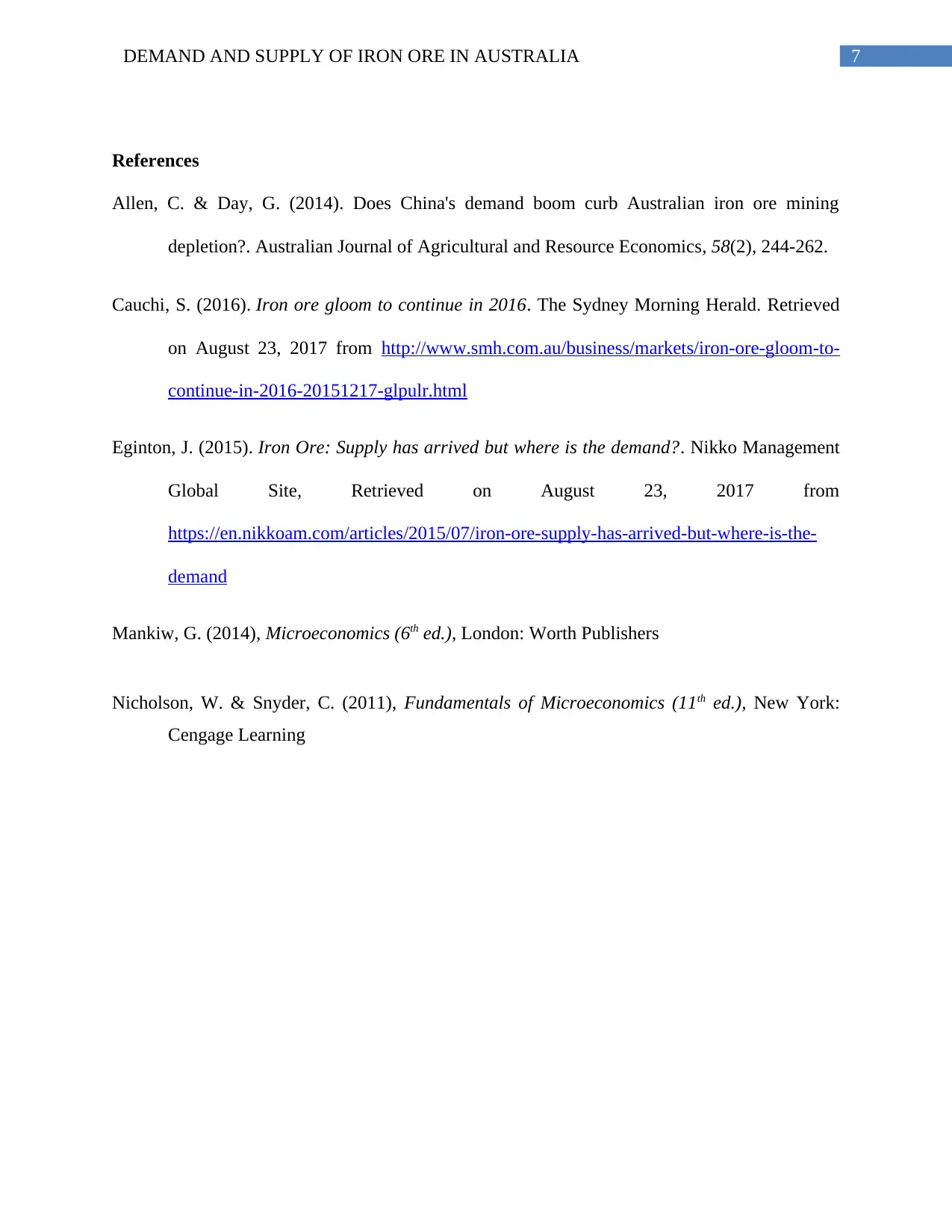
7DEMAND AND SUPPLY OF IRON ORE IN AUSTRALIA
References
Allen, C. & Day, G. (2014). Does China's demand boom curb Australian iron ore mining
depletion?. Australian Journal of Agricultural and Resource Economics, 58(2), 244-262.
Cauchi, S. (2016). Iron ore gloom to continue in 2016. The Sydney Morning Herald. Retrieved
on August 23, 2017 from http://www.smh.com.au/business/markets/iron-ore-gloom-to-
continue-in-2016-20151217-glpulr.html
Eginton, J. (2015). Iron Ore: Supply has arrived but where is the demand?. Nikko Management
Global Site, Retrieved on August 23, 2017 from
https://en.nikkoam.com/articles/2015/07/iron-ore-supply-has-arrived-but-where-is-the-
demand
Mankiw, G. (2014), Microeconomics (6th ed.), London: Worth Publishers
Nicholson, W. & Snyder, C. (2011), Fundamentals of Microeconomics (11th ed.), New York:
Cengage Learning
References
Allen, C. & Day, G. (2014). Does China's demand boom curb Australian iron ore mining
depletion?. Australian Journal of Agricultural and Resource Economics, 58(2), 244-262.
Cauchi, S. (2016). Iron ore gloom to continue in 2016. The Sydney Morning Herald. Retrieved
on August 23, 2017 from http://www.smh.com.au/business/markets/iron-ore-gloom-to-
continue-in-2016-20151217-glpulr.html
Eginton, J. (2015). Iron Ore: Supply has arrived but where is the demand?. Nikko Management
Global Site, Retrieved on August 23, 2017 from
https://en.nikkoam.com/articles/2015/07/iron-ore-supply-has-arrived-but-where-is-the-
demand
Mankiw, G. (2014), Microeconomics (6th ed.), London: Worth Publishers
Nicholson, W. & Snyder, C. (2011), Fundamentals of Microeconomics (11th ed.), New York:
Cengage Learning
1 out of 7
Related Documents
Your All-in-One AI-Powered Toolkit for Academic Success.
+13062052269
info@desklib.com
Available 24*7 on WhatsApp / Email
![[object Object]](/_next/static/media/star-bottom.7253800d.svg)
Unlock your academic potential
Copyright © 2020–2025 A2Z Services. All Rights Reserved. Developed and managed by ZUCOL.





